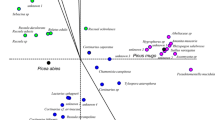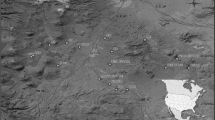Abstract
The composition, structure and temporal variation of ectomycorrhizal (EM) communities associated with mountain avens (Dryas octopetala) in grass heaths of the Burren, western Ireland were assessed by using soil core sampling in two permanent plots and 30 other sites (196 cores in total). Of the 34 different EM types observed, 11 were common and constituted over 80% of the EM biomass. Four EM types, Craterellus lutescens, Tomentella sp., Dryadirhiza fulgens and Cenococcum geophilum were the most abundant as measured by EM length and frequency of occurrence in cores. The species profile and relative abundances were very similar in cores from the permanent plots and different sites in the Burren, indicating that they were all representative of the same EM community. The below-ground EM community in both plots was compared with production of basidiomes, and the latter was found to be an unreliable indicator of EM community structure. Temporal variation in the EM community was assessed by repeated core sampling of the two permanent plots over a 14-month period (between March 1998 and May 1999). No statistically significant shifts in EM abundance were found between sampling dates, probably as a consequence of the large variation in EM abundance between core samples over the sampling period. No significant relationship was found between rainfall, soil moisture or soil temperature and fluctuations in EM abundance. Patterns of total EM abundance and fluctuations in EM diversity were strongly correlated between the two permanent plots over the sampling period. Temporal fluctuations in the dominant EM type, Craterellus lutescens, were similar in both plots with respect to mycorrhizal length, biomass and relative abundance, and the patterns between both plots were positively correlated. EM diversity was negatively correlated with biomass of ectomycorrhizas of Craterellus lutescens in both plots, but it was significant only in plot 1.





Similar content being viewed by others
References
Acsai J, Largent DL (1983) Mycorrhizae of Arbutus menziesii Pursh and Arctostaphylos manzanita Parry in Northern California. Mycotaxon 16:19–536
Agerer R (1986) Studies on ectomycorrhizae II. Introducing remarks on characterisation and identification. Mycotaxon 26:473–492
Baxter JW, Pickett ST, Carreiro MM, Dighton J (1999) Ectomycorrhizal diversity and community structure in oak forest stands exposed to contrasting anthropogenic impacts. Can J Bot 77:771–782
Bledsoe C, Klein P, Bliss LC (1990) A survey of mycorrhizal plants on Truelove Lowland, Devon Island, N.W.T., Canada. Can J Bot 68:1848–1856
Brand F (1991) Ektomykorrhiza an Fagus sylvatica. Charakterisierung und Identifizierung, ökologische Kennzeichnung und unsterile Kultivierung. Libri Bot 2:1–228
Dahlberg A (2001) Community ecology of ectomycorrhizal fungi: an advancing interdisciplinary field. New Phytol 150:555–562
Danielson RM (1991) Temporal changes and effects of amendments on the occurrence of sheathing (ecto-) mycorrhizas of conifers growing in oil sands tailings and coal spoil. Agric Ecosyst Environ 35:261–281
Danielson RM, Zak JC, Parkinson D (1984) Mycorrhizal inoculum in a peat deposit formed under a white spruce stand in Alberta. Can J Bot 63:2557–2560
Deacon JW, Fleming LV (1992) Interactions of ectomycorrhizal fungi. In: Allen MF (ed) Mycorrhizal functioning: an integrative plant-fungal process. Chapman and Hall, London, pp 249–300
Egli S, Amiet R, Zollinger M, Schneider B (1993) Characterization of Picea abies (L.) Karst. ectomycorrhizas: discrepancy between classification according to macroscopic versus microscopic features. Trees 7:123–129
Erland S, Taylor AFS (1999) Resupinate ectomycorrhizal fungal genera. In: Cairney JWG, Chambers SM (eds) Ectomycorrhizal fungi: key genera in profile. Springer, Berlin Heidelberg New York, pp 348–363
Erland S, Jonsson T, Mahmood S, Finlay RD (1999) Below-ground ectomycorrhizal community structure in two Picea abies forests in southern Sweden. Scand J For Res 14:209–217
Fransson PMA, Taylor AFS, Finlay RD (2000) Effects of continuous optimal fertilization on belowground ectomycorrhizal community structure in a Norway spruce forest. Tree Physiol 20:599–606
Gardes M, Bruns TD (1996) Community structure of ectomycorrhizal fungi in a Pinus muricata forest: above- and below-ground views. Can J Bot 74:1572–1583
Gehring CA, Theimer TC, Witham TC, Keim P (1998) Ectomycorrhizal fungal community structure of pinyon pines growing in two environmental extremes. Ecology 79:1562–1572
Graf F, Brunner I (1996) Natural and synthesised ectomycorrhizas of the alpine dwarf willow Salix herbacea. Mycorrhiza 6:227–235
Harrington T (1996) Observations on the macrofungi of Dryas communities in the Burren, western Ireland. Ir Nat J 25:157–192
Harrington TJ (2003) Relationships between macrofungi and vegetation in the Burren. Biol Environ 103B:147–159
Harrington TJ, Mitchell DT (2002) Characterization of Dryas octopetala ectomycorrhizas from limestone karst vegetation, western Ireland. Can J Bot 80:970–982
Harrington TJ, Mitchell DT (2005) Ectomycorrhizas associated with a relict population of Dryas octopetala in the Burren, western Ireland. I. Distribution of ectomycorrhizas in relation to vegetation and soil characteristics. Mycorrhiza (in press) DOI 10.1007/s00572-005-0347-4
Heijden EW van der, Vosatka M (1999) Mycorrhizal associations of Salix repens L. communities in succession of dunes ecosystems. II. Mycorrhizal dynamics and interactions of ectomycorrhizal and arbuscular mycorrhizal fungi. Can J Bot 77:1833–1841
Heijden EW van der, de Vries FW, Kuyper TW (1999) Mycorrhizal associations of Salix repens L. communities in succession of dunes ecosystems. I. Above-ground and below-ground views of ectomycorrhizal fungi in relation to soil chemistry. Can J Bot 77:1821–1832
Horn HS (1966) Measurement of “overlap” in comparative ecological studies. Am Nat 100:419–424
Horton TR, Bruns TD (2001) The molecular revolution in ectomycorrhizal ecology: peeking into the black box. Mol Ecol 10:1855–1871
Horton TR, Bruns TD, Parker VT (1999) Ectomycorrhizal fungi associated with Arctostaphylos contribute to Pseudotsuga menziesii establishment. Can J Bot 77:93–102
Jeffrey DW (2003) Grassland and heath: a review and hypothesis to explain the distribution of Burren plant communities. Biol Environ 103B:111–124
Jonsson L, Dahlberg A, Nilsson M-C, Zackrisson O, Kårén O (1999) Ectomycorrhizal fungal communities in late-successional Swedish boreal forests, and their composition following wildfire. Mol Ecol 8:205–215
Kårén O, Nylund J-E (1997) Effects of ammonium sulphate on the community structure and biomass of ectomycorrhizal fungi in a Norway spruce stand in southwestern Sweden. Can J Bot 75:1628–1642
Kernaghan G (2001) Ectomycorrhizal fungi at tree line in the Canadian Rockies II. Identification of ectomycorrhizae by anatomy and PCR. Mycorrhiza 10:217–229
Kernaghan G, Currah R (1998) Ectomycorrhizal fungi at tree line in the Canadian Rockies. Mycotaxon 69:39–80
Kernaghan G, Harper KA (2001) Community structure of ectomycorrhizal fungi across an alpine/subalpine ecotone. Ecography 24:181–188
Krebs CJ (1989) Ecological methodology. Harper and Row, New York
Largent DL, Sugihara N, Wishner C (1980) Occurrence of mycorrhizae on ericaceous and pyrolaceous shrubs and subshrubs in northern California. Can J Bot 58:2274–2279
Last FT, Mason PA, Wilson J, Deacon JW (1983) Fine roots and sheathing mycorrhizas: their formation, function and dynamics. Plant Soil 71:9–21
Mahmood S, Finlay RD, Erland S (1999) Effects of repeated harvesting of forest residues on the ectomycorrhizal community in a Swedish spruce forest. New Phytol 142:577–585
Mason PA, Last FT, Pelham J, Ingleby K (1982) Ecology of some fungi associated with an ageing stand of birches (Betula pendula and B. pubescens). For Ecol Manag 4:19–39
Mejstrik V, Hadac E (1975) Mycorrhizas of Arctostaphylos uva-ursi. Pedobiologia 15:336–342
Morisita M (1959) Measuring of interspecific association and similarity between communities. Mem Fac Sci Kyushu Univ Ser E 3:65–80
Morisita M (1962) Id-index, a measure of dispersion of individuals. Res Popul Ecol 4:1–7
Peter M, Ayer F, Egli S (2001) Nitrogen addition in a Norway spruce stand altered macromycete basidiome production and below-ground species composition measured by PCR-RFLP analysis of the ribosomal ITS-region. New Phytol 149:311–326
Shannon CE (1948) A mathematical theory of communication. Bell Syst Tech J 27:379–423
Simpson EH (1949) Measurement of diversity. Nature 163:688
Smith-Gill SJ (1975) Cytophysiologial basis of disruptive pigmentary patterns in the leopard frog Rana pipiens. II. Wild type and mutant cell-specific patterns. J Morphol 146:35–54
Taylor AFS, Alexander IJ (1989) Demography and population dynamics of ectomycorrhizas of sitka spruce fertilized with N. Agric Ecosyst Environ 28:493–496
Tennant D (1975) A test of a modified line intersection method for measuring root length. J Appl Ecol 63:995–1001
Visser S (1995) Ectomycorrhizal fungal succession in jack pine following wildfire. New Phytol 129:389–401
Vogt KA, Edmonds RL, Grier CC (1981) Dynamics of ectomycorrhizae in Abies amabilis stands: the role of Cenococcum graniforme. Holarct Ecol 4:167–173
Worley JF, Hacskaylo E (1959) The effect of available soil moisture on the mycorrhizal associations of Virginia pine. For Sci 5:267–268
Zar JH (1999) Biostatistical analysis, 4th edn. Prentice Hall, New Jersey
Acknowledgements
The assistance and advice of Andy Taylor, Anna Rosling and Roger Finlay (Department of Forest Mycology and Pathology, Swedish University of Agricultural Sciences, Uppsala, Sweden) are gratefully acknowledged.
Author information
Authors and Affiliations
Corresponding author
Rights and permissions
About this article
Cite this article
Harrington, T.J., Mitchell, D.T. Ectomycorrhizas associated with a relict population of Dryas octopetala in the Burren, western Ireland II. Composition, structure and temporal variation in the ectomycorrhizal community. Mycorrhiza 15, 435–445 (2005). https://doi.org/10.1007/s00572-005-0348-3
Received:
Accepted:
Published:
Issue Date:
DOI: https://doi.org/10.1007/s00572-005-0348-3




